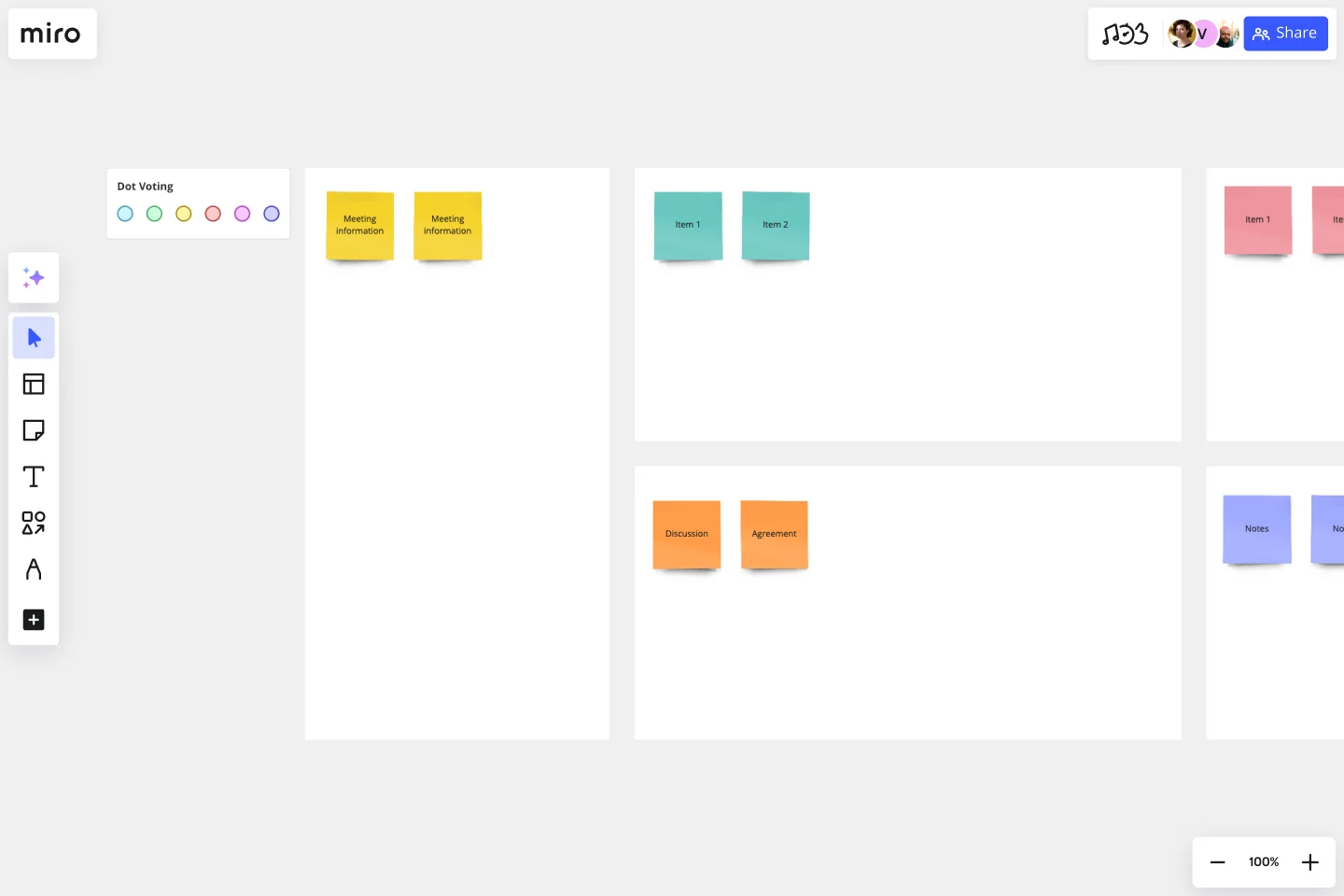Meeting Notes Template
Create a lasting record of what happened during a meeting.
About the Meeting Notes template
If someone asked you how many meetings you have in a given week, you’d probably find it hard to answer -- not because you don’t pay attention, but because you have so many! When you’re in and out of important meetings all day, it can be difficult to remember who said what, or what goals everyone agreed on.
Meeting notes are simply a record of your meeting. Most teams prefer to assign a notetaker at the beginning of each meeting, so one person can focus on capturing the contents of the meeting instead of having everyone scramble to capture what they can. Many teams rotate the notetaker so everyone has an equal stake in the meeting.
Who should use the meeting notes template?
Any team that wants to keep a written record of what happened during a meeting. This is especially important for meetings with action items, deadlines, and decisions. You can assign one person to be responsible or you may want to rotate duties so that a different person is responsible for updating the meeting notes each time.
How to create meeting notes
Step 1: Assign a notetaker before the meeting.
Step 2: Decide on the topics you’re going to cover for the meeting. The notetaker can make a note of these topics.
Step 3: During the meeting, ask the notetaker to summarize the notes from the previous meeting to give you a starting point.
Step 4: Have the notetaker take down the names of the participants, agenda times, action items and due dates, and the main points from the meeting.
Step 5: As the meeting continues, the notetaker can continue to take note of any decisions made by the participants, the most important points covered, and any future decisions that need to be made.
Step 6: The notetaker can share the meeting notes with the team, if appropriate.
How do you use the meeting notes template?
Start with our pre-made template, making any changes you’d like to suit your particular needs. Invite team members to join your board and collaborate. Use the @mention or video chat if you need to get input from others. You can upload other file types such as documents, photos, videos, and PDFs to store all the relevant information in one place.
Get started with this template right now.
SMART Goals Template
Works best for:
Prioritization, Strategic Planning, Project Management
Setting goals can be encouraging, but can also be overwhelming. It can be hard to conceptualize every step you need to take to achieve a goal, which makes it easy to set goals that are too broad or too much of a stretch. SMART is a framework that allows you to establish goals in a way that sets you up for success. SMART stands for Specific, Measurable, Attainable, Relevant, and Timely. If you keep these attributes in mind whenever you set goals, then you’ll ensure your objectives are clear and reachable. Your team can use the SMART model anytime you want to set goals. You can also use SMART whenever you want to reevaluate and refine those goals.
Plus Delta Template
Works best for:
Software Development, Meetings, Retrospectives
The Plus Delta template is a simple but powerful tool for collecting constructive criticism from a group. The format encourages you and your team to focus on what went well, what you should repeat in the future, and what you should aim to change. To complete a Plus Delta template, simply make note of things that are working and things you would like to improve. You can then file these elements into two separate columns. Use Plus Delta to showcase wins and learnings for your team, stakeholders, employees, and bosses.
3-Circle Venn Diagram
Works best for:
Education, Diagrams, Brainstorming
Venn diagrams have been a staple of business meetings and presentations since the 1800s, and there’s a good reason why. Venn diagrams provide a clear, effective way to visually showcase relationships between datasets. They serve as a helpful visual aid in brainstorming sessions, meetings, and presentations. You start by drawing a circle containing one concept, and then draw an overlapping circle containing another concept. In the space where the circles overlap, you can make note of the concepts’ similarities. In the space where they do not, you can make note of their differences.
Azure Demand Forecasting Template
Works best for:
Software Development, Diagrams
The Azure Demand Forecasting diagram will show the architecture of a demand forecast, making it easier for you to predict data consumption, costs, and forecast results. Azure is Microsoft’s cloud computing platform, designed to provide cloud-based services such as remote storage, database hosting, and centralized account management. Azure also offers new capabilities like AI and the Internet of Things (IoT).
Brand Strategy Template
Works best for:
Marketing
Develop a brand strategy for new and existing brands with this fully guided Brand Strategy Template. Find new ways to build your brand and set your business up for success.
One-on-one Meeting Template
Works best for:
Meetings
Ensure your meetings are productive by using a one-on-one meeting template. Create and stick to your agenda items, understand what’s going well, what isn’t working, and how to improve. Discuss what’s been accomplished and what’s still in progress.
